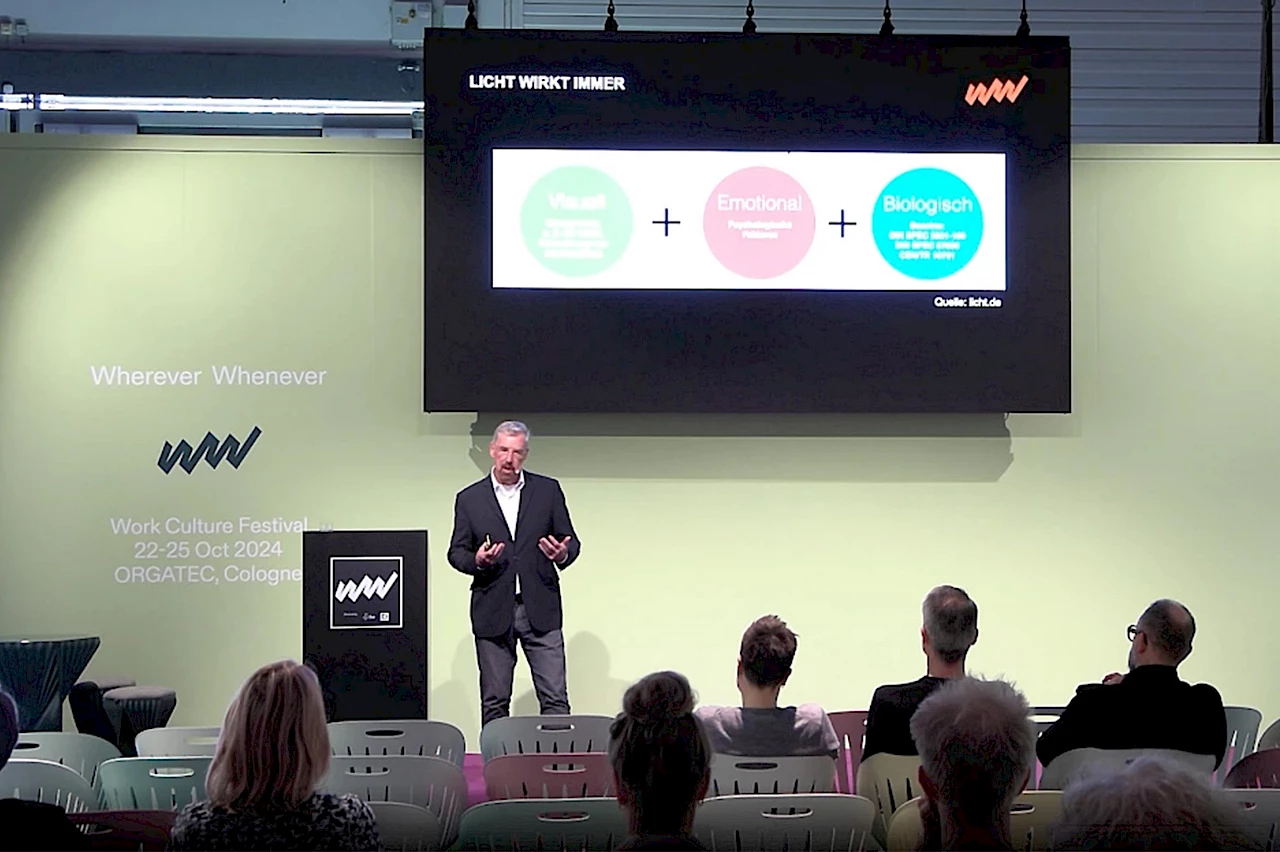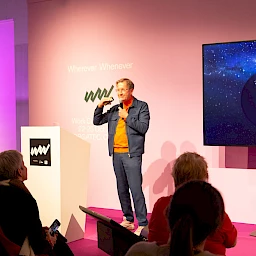During the Work Culture Festival, engineer and lighting expert Heiner Hans discussed approaches for implementing customized, flexible and sustainable lighting systems in office environments. His presentation focussed on planning principles, practical examples and the importance of human-centric lighting in modern workplace concepts.
From standardized lighting to customized solutions
For many years, it was standard practice to equip offices with uniform wall-to-wall lighting systems. The aim of this model was to create the same lighting conditions throughout an entire office. In Hans’ opinion, this approach is no longer adequate for today’s working environments. Different activities, age groups and cultural influences require differentiated lighting solutions. He used the example of an architectural firm to illustrate this: whereas a CAD draughtsman needs as little scattered light as possible in order to clearly recognize fine lines on a computer screen, a colleague in the customer service department prefers a cosy lighting atmosphere for conversations. Other employees need more brightness as they get older, while younger colleagues can often cope with lower levels of illumination. Hans emphasized the fact that modern lighting systems must provide brightness, light colour and a dynamic atmosphere as the situation requires. Human-centric lighting (HCL), which technically simulates the course of daylight and thus supports the circadian clock, is an important element of such systems. HCL can provide light with an activating or calming effect depending on the situation, and it can also promote both concentration and well-being.
Flexibility as a basis for planning
In addition to the aspect of customization, Hans focussed on the flexibility of lighting systems. Today, office spaces change in short cycles due to new room layouts, agile working methods, project work or changing team sizes. A modern lighting system should therefore be designed in such a way that it can be adapted to different situations without having to make major structural changes or spend a lot of money. Solutions here include modular systems in which luminaire inserts can be swapped or added to as required. Equally important are movable floor or table lamps that can be used at different workstations in order to meet individual lighting requirements. Hans emphasized the fact that flexible planning should not be limited to the selection of luminaires but should instead also include the integration of the latter into a higher-level lighting management system. Such systems make it possible to adapt scenarios to new room layouts, define different work zones and link lighting concepts with other building functions, such as sun shading or air conditioning. Flexibility also means that a system remains adjustable not only during commissioning, but also during ongoing operation. For example, if a team structure changes, it should be possible to program new lighting scenes or accentuate individual areas more strongly.
Sustainability over the entire life cycle
Hans emphasized sustainability as the third focal point. The switch from fluorescent lamps to LED technology has already enabled significant energy savings. Nevertheless, according to Hans, sustainability must be considered more comprehensively and take into account all phases of a lighting system’s life cycle. Consistent lighting management is a key factor here. Systems with presence detectors and daylight sensors ensure that artificial light is only used where and when it is actually needed. In this way, energy consumption can be significantly reduced and the service life of LEDs can be extended, as LEDs are less heavily loaded when they are dimmed. This has a positive effect on both operating costs and the carbon footprint.
Hans also pointed out that sustainability does not end with operations, as production, transport and disposal should also be included in sustainability planning processes. Many luminaires are made of metals such as aluminium or steel, which are easy to recycle. LED circuit boards, which contain rare raw materials, are more difficult to recycle. It therefore makes sense to use particularly efficient LEDs in order to utilize as few components as possible, and planning should also focus on products whose components can be replaced. Repairable systems with a spare parts guarantee extend service life considerably and help avoid unnecessary new purchases. “A long service life is the greatest lever for sustainability,” is how Hans put it. He also drew attention to the industry’s ongoing efforts to develop product passports that provide planners and operators with clear information on materials, reparability and recyclability. This could enable sound decisions that meet both ecological and economic requirements.
User focus as a success factor
Another key topic of Hans’ presentation was the consistent involvement of users. According to Hans, lighting systems are often installed without employees being sufficiently familiarized with their operation and possibilities. As a result, the potential of modern systems remains unutilized, while at the same time there is a risk that employees will resort to their own solutions, such as private desk lamps. Hans therefore argued in favour of taking the user perspective into account as early as the planning phase, identifying expectations in workshops and obtaining feedback after a certain period of use. This is the only way to create acceptance and ensure that lighting solutions are fully effective.
To conclude: lighting is a central component of modern working environments. It not only fulfils functional tasks; it also influences atmosphere, health and motivation. Three aspects are decisive here: customized adaptation to different activities and needs, flexibility to accompany changing spatial and usage concepts, and sustainability over the entire life cycle of luminaires and systems. Combined with a consistent user focus, this creates the basis for working environments that remain efficient and attractive over the long term.






